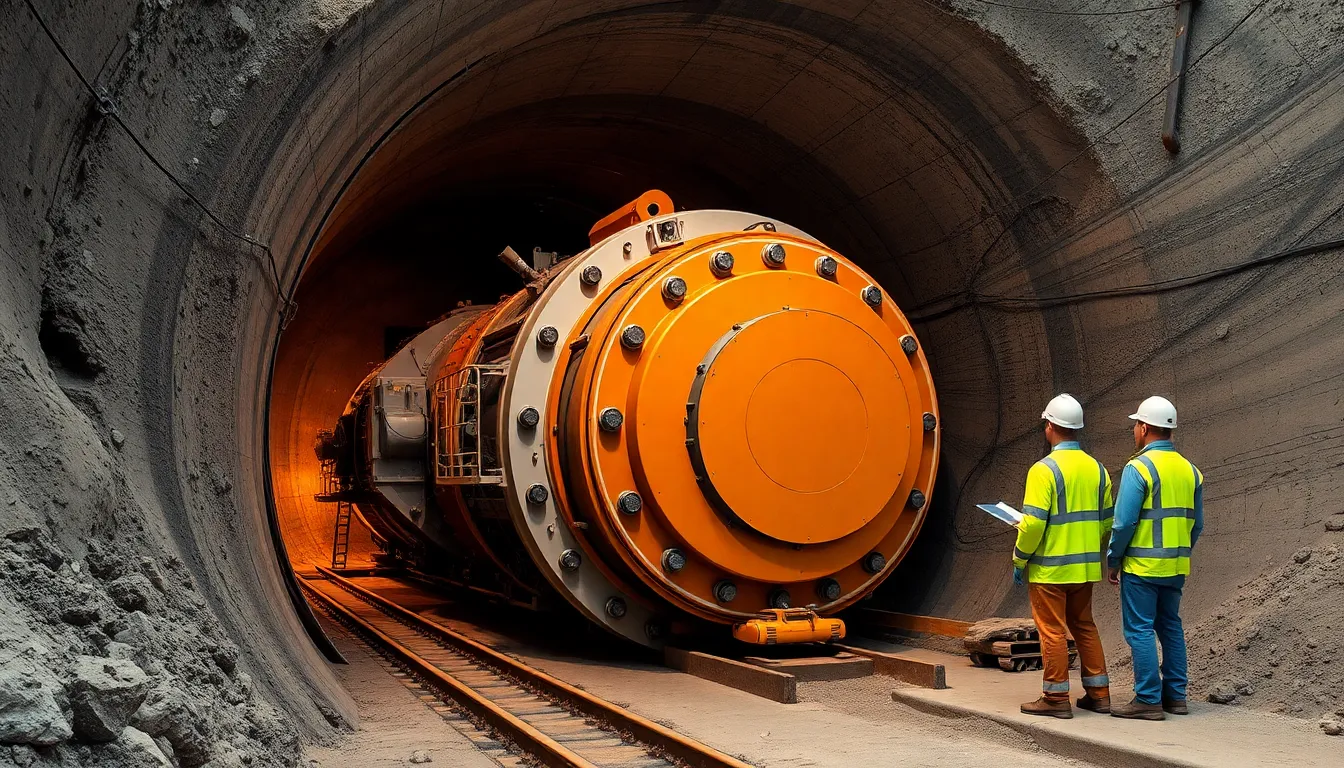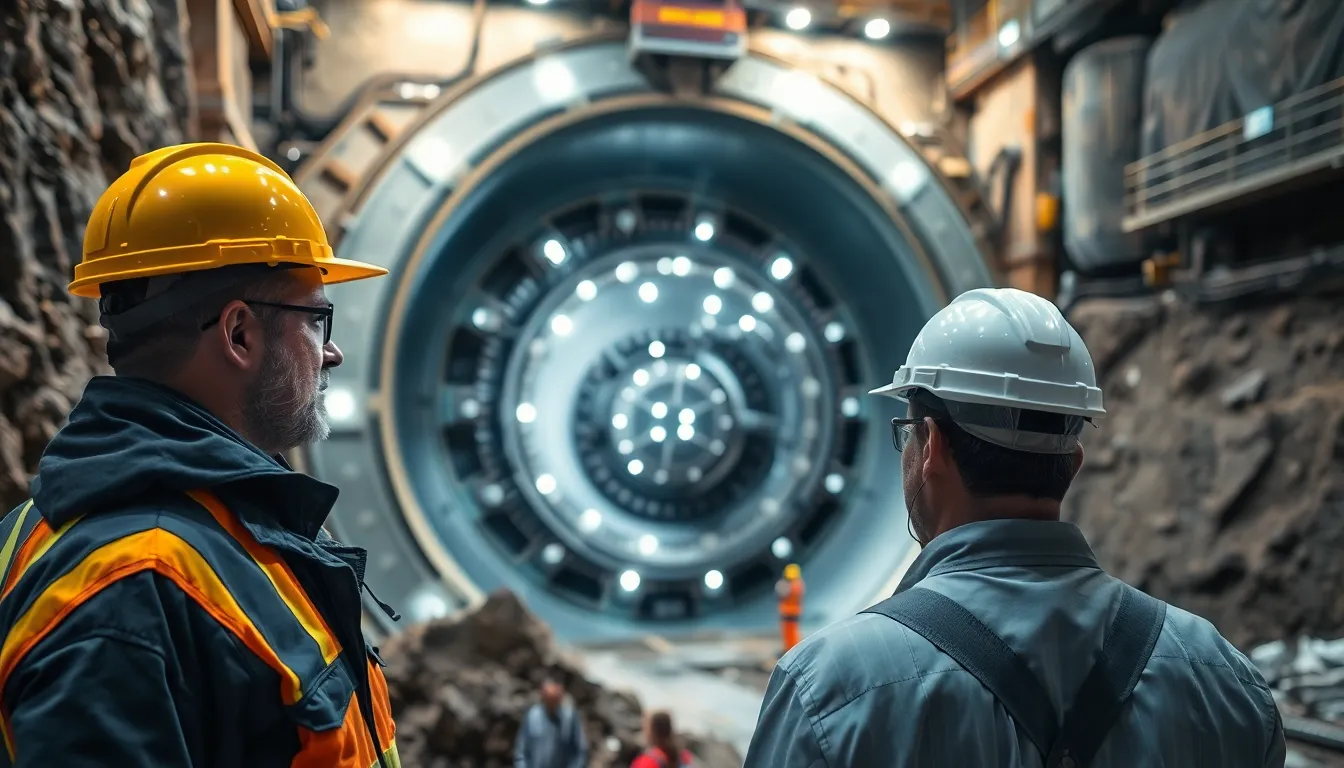Imagine a world where cities expand not just outward but downward, creating a hidden realm of innovation beneath our feet. Tunnelling and underground space technology are revolutionizing urban landscapes, offering solutions to overcrowding and infrastructure challenges. With the ability to create vast networks of tunnels, engineers are transforming how we think about space—because who needs a backyard when you can have a subterranean paradise?
Table of Contents
ToggleOverview of Tunnelling and Underground Space Technology
Tunnelling and underground space technology encompasses methods and innovations that allow for the construction and effective utilization of subterranean environments. Engineers use advanced techniques to create tunnels, providing solutions to urban overcrowding and infrastructure limitations. This technology supports various applications, including transportation, utilities, and commercial spaces, transforming urban landscapes to meet growing demands.
Innovative machinery and tools facilitate efficient tunnelling processes. Shield tunnelling machines, for instance, enhance safety and minimize environmental impact, making them preferable for city-centric projects. Studies show that these approaches reduce land disruption and improve project timelines.
Designing underground spaces involves careful planning and engineering. Different geological conditions influence the choice of construction methods, leading to diverse strategies across regions. Engineers evaluate soil types, groundwater levels, and seismic activity to ensure stability and safety in underground projects.
The integration of smart technologies further enhances tunnelling and underground space applications. Automation and monitoring systems optimize construction efforts, leading to increased efficiency and reduced costs. Data collected from sensors in tunnels provides valuable insights for ongoing maintenance and future expansions.
Sustainable practices play a significant role in the development of underground spaces. Recycling materials from excavated earth contributes to environmentally friendly construction solutions. Implementing energy-efficient systems within underground environments promotes long-term ecological benefits while maximizing usability.
Collaborative efforts among architects, engineers, and urban planners are essential for successful underground developments. They collectively address challenges while maximizing the potential of subterranean spaces. As urban areas continue to evolve, tunnelling and underground space technology offer innovative solutions for modern cityscapes.
Historical Development

The evolution of tunneling and underground space technology showcases significant milestones that shaped modern engineering practices.
Early Innovations
Ancient civilizations utilized basic tunneling techniques to construct aqueducts and mines. Romans established complex underground structures, including sewer systems like the Cloaca Maxima. These early innovations laid the groundwork for modern tunneling techniques. The development of mechanical tools in the 19th century transformed tunneling, allowing engineers to create more extensive networks. Miners often employed hand tools and explosives to carve out passageways, demonstrating the resourcefulness of past engineers. Significant projects, such as the Thames Tunnel in London, marked the first successful underwater tunnel, showcasing the potential of underground construction.
Modern Advancements
The 20th century introduced revolutionary advancements in tunneling technology. Engineers began using tunnel boring machines (TBMs), drastically improving efficiency and safety. Modern TBMs can excavate large diameters while minimizing surface disruption. Computer modeling and geological analysis became essential tools for planning subterranean projects. This technology enabled precise predictions of geological conditions and potential hazards. Additionally, the introduction of smart technologies integrated into tunneling operations significantly enhanced monitoring and coordination. Contemporary practices emphasize sustainability, optimizing energy usage and recycling materials. Collaborative approaches among multidisciplinary teams now drive innovation in underground infrastructure development.
Key Techniques in Tunnelling
Tunnelling employs various advanced techniques tailored to meet specific project requirements and geological conditions. Each method enhances safety, efficiency, and environmental considerations.
Shield Tunnelling
Shield tunnelling utilizes a specialized machine to excavate tunnels while simultaneously installing concrete linings. This technique protects workers from ground instability and minimizes surface disruption. Operators control the machine’s cutting head, allowing adaptability to diverse soil conditions. Significant advancements in shield design improve performance across various terrains and geological challenges. Projects like hydropower tunnels and urban transit systems benefit from this approach, reinforcing its relevance in modern tunnelling.
Cut-and-Cover Method
Cut-and-cover involves excavating a trench, constructing a tunnel within, and then covering it. This method typically suits shallow tunnelling for roads or railways. Contractors can execute this technique in urban areas with manageable surface conditions. Efficient excavation and construction material use often characterize this approach. Frequent applications occur in subway construction, highlighting its effectiveness for projects that require minimal tunnelling depth.
Sequential Excavation Method
Sequential excavation allows for controlled excavation of tunnels, particularly in challenging ground conditions. Using a combination of manual and mechanical techniques, crews excavate the tunnel in sections. This method enhances stability during construction and allows for immediate support installation. Operators adapt to varying geological conditions while reducing the risk of collapse. Commonly applied in soft ground or urban settings, sequential excavation proves invaluable for intricate tunnelling work.
Applications of Underground Space Technology
Underground space technology finds widespread applications across various sectors, addressing urban challenges and enhancing infrastructure.
Transportation Infrastructure
Transportation infrastructure benefits significantly from underground developments. Subterranean spaces accommodate metro systems, alleviating surface congestion. Additionally, these tunnels facilitate efficient movement of goods and people, exemplified by projects like the Crossrail in London. Safe transportation routes rely on advanced tunneling techniques, ensuring durability and resilience against seismic events. Cities leverage underground railways to minimize traffic noise and maximize land use. Researchers continually explore innovations that enhance connectivity and support the growing demand for urban transit systems.
Utility Networks
Utility networks rely on efficient underground solutions for essential services. Water supply systems, sewer lines, and electrical grids utilize tunneling methods to embed infrastructure beneath the surface. This approach minimizes disruption to urban environments and protects utilities from weather-related damage. Moreover, underground utility systems can enhance overall service reliability and reduce maintenance costs. Engineers assess geological conditions to optimize the design and placement of these networks, ensuring long-term functionality and efficiency. Sustainable practices in utility installation contribute to resource conservation and improved service access.
Underground Storage Solutions
Underground storage solutions provide viable options for various industries. Facilities designed for waste management securely house materials while minimizing environmental risks. In addition, underground spaces serve as storage for valuable commodities, such as oil and gas, protecting resources from natural disasters and theft. Companies utilize subterranean areas as climate-controlled environments for sensitive inventory, ensuring product safety. Businesses increasingly recognize the advantages of underground storage, leading to innovative design and construction methods that enhance spatial efficiency.
Challenges and Considerations
Challenges arise in tunneling and underground space technology, impacting urban development. Key concerns include environmental impact and safety measures, both critical for project success.
Environmental Impact
Environmental impact plays a significant role in tunneling projects. Soil disturbance and water table alterations generate concerns during excavation. Additionally, emissions from equipment contribute to air pollution, requiring mitigation strategies. Designers implement sustainable practices to minimize ecological footprints, emphasizing recycled materials and energy-efficient methods. Depending on the local ecosystem, biodiversity assessments may guide project development, further underscoring the importance of environmentally conscious planning.
Safety Measures
Safety measures are essential in underground construction. Hazards like cave-ins and harmful gas emissions pose risks to workers and the environment. Engineers rely on real-time monitoring systems to track ground conditions, ensuring quick responses to potential threats. Extensive training for personnel on safety protocols fosters a culture of awareness and risk management. Emergency preparedness plans, including evacuation routes and communication strategies, further enhance safety for all involved in underground projects.
Future Trends in Tunnelling
Innovations in tunneling technology are rapidly evolving, shaping the future of underground construction. Key trends reflect a shift towards smarter, more sustainable practices.
Smart Tunnelling Systems
Intelligent tunnelling systems integrate advanced technologies for enhanced efficiency. These systems employ real-time data analysis to monitor geological conditions, facilitating proactive adjustments during excavation. Automation plays a vital role, with autonomous machines handling repetitive tasks and reducing human error. High-precision sensors detect variations in ground stability, enabling timely interventions. This technological synergy leads to safer operations and decreased excavation times. Projects like the Gautrain in South Africa showcase these advancements, demonstrating improved urban mobility using smart methods.
Sustainable Practices
Sustainable practices in tunneling focus on minimizing environmental impact and resource consumption. Employing eco-friendly materials and energy-efficient methods is crucial. Many companies now prioritize the use of recycled materials, which reduces waste and conserves natural resources. Innovative tunneling techniques, such as the use of closed-loop water systems, help manage water resources effectively and prevent contamination. Implementing biodiversity assessments ensures that projects consider ecological impacts on surrounding environments. Overall, a commitment to sustainability positions tunneling as a forward-thinking solution to urban development challenges.
Tunneling and underground space technology are crucial in addressing urban challenges. With cities facing overcrowding and infrastructure strain, these innovations offer sustainable alternatives to traditional development.
The evolution of tunneling techniques and the integration of smart technologies pave the way for safer and more efficient underground spaces. As urban planners and engineers collaborate, the potential for enhanced transportation and utility networks expands.
Looking ahead, the focus on sustainability and environmental impact will continue to shape the future of underground construction. Embracing these advancements not only redefines urban landscapes but also ensures a balanced coexistence with nature.




